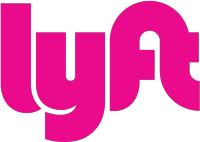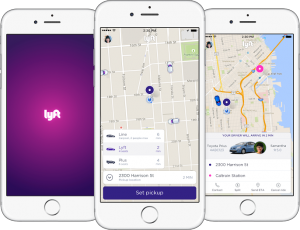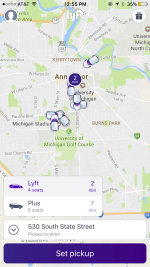Difference between revisions of "Lyft"
(→Pricing) |
(→Safety) |
||
| Line 83: | Line 83: | ||
* In-person interview with current Lyft driver | * In-person interview with current Lyft driver | ||
Drivers that meet all requirements are covered by the Lyft Insurance Protection Plan that utilizes Lyft's $1 million liability insurance. The liability serves as primary to the driver's personal automobile insurance policy as soon as they switch into driver mode until the moment they drop off their passenger.<ref>Lyft Safety https://www.lyft.com/safety</ref> | Drivers that meet all requirements are covered by the Lyft Insurance Protection Plan that utilizes Lyft's $1 million liability insurance. The liability serves as primary to the driver's personal automobile insurance policy as soon as they switch into driver mode until the moment they drop off their passenger.<ref>Lyft Safety https://www.lyft.com/safety</ref> | ||
| + | |||
| + | There have been some concerns over passenger and driver safety, including some incidents. In 2014 a driver was punched in the face by a passenger after the passenger was asked to stop smoking. <ref name="forbes">Hill, Kashmir.[https://www.forbes.com/sites/kashmirhill/2014/05/21/lyft-passenger-breaks-seattle-drivers-nose/#4ab76a521017 "Lyft's Moment of Truth As Passenger Breaks Seattle Driver's Nose"] '''Forbes''' (21 May 2014. Retrieved 22 April 2017). </ref> In a response from Lyft, they noted that the passenger's Lyft account was deactivated and that he was blocked from making any new Lyft accounts. <ref name="forbes"</ref> | ||
====Passenger Discrimination==== | ====Passenger Discrimination==== | ||
Revision as of 21:23, 22 April 2017
|
Contents
History

John Zimmer attended Cornell University and has a background in hospitality; he was particularly inspired by a class he took on the evolution of creating greener cities, which led to the idea of streamlining transportation with more effective models. When learning about cars and the road system he was intrigued by the low rate of occupancy of public transportation. He realized that if you could increase the occupancy by a mere ten percent, it would create a more efficient society. Logan Green's background was specifically in transportation hacking, as he built the first car-share program even before Zipcar, at the University of California at Santa Barbara. He was constantly frustrated with the public transportation system and how it was funded. He wanted to build a transportation system that was operated and financed in a better way. [2]
John Zimmer and Logan Green founded Lyft on May 22nd, 2012. They originally created a company called Zimride in 2007, which was very similar to Lyft but was geared towards long distance rides connecting people through Facebook. [3] The lack of short distance journeys was what seemed to be missing from this company, which is why they created Lyft in San Francisco. [4] Lyft has given Uber some serious competition with low-priced private drivers that are accessible by the click of a button. Lyft complemented Zimride, as these companies were accessible to ridesharers for both short and long distances. Zimride was sold to Enterprise on July 10th, 2013, as Lyft was turning out to be far more profitable for Zimmer and Green. [5]
Passenger Application Features
How to Start Using the Application
In order to be a customer on the service, users must create an account linked to their phone number and credit card, Google Wallet, or PayPal account. When using the phone app, Lyft uses GPS tracking to determine the location of the user and the availability of cars around them. In order to request a ride, a user must confirm the pickup location and select the type of car they would prefer. The user can then add their destination and view a price estimate, which includes additional charges that typically occur during times of day in which rides are in high demand or traffic is heavier than usual. The user then taps the “Requests Lyft” button and they are connected with the closest driver in the area.
Once the driver within their vicinity has been connected to the user, the application provides the driver’s estimated arrival time based upon the distance and current traffic conditions. As the Lyft approaches, the rider is provided with the driver’s name, rating, car make and model, and the license plate number. Users can track the location of their car in relation to the pickup location on the application’s map, and can also view the estimated time until the car arrives, can contact the driver, split the fee for the ride with friends, send the estimated time of arrival to others, and cancel the ride from this screen. [6]
In March of 2015, Lyft made it possible for users to add personal profiles including where they are from and favorite music to encourage more personal connections between the passengers and their drivers. [7]
Lyft Tiers
Lyft
Lyft is the application's most basic service as well as the lowest cost option. Vehicles in this class generally seat up to four passengers. [8] It is the most popular option for Lyft users.
Lyft Plus
Lyft Plus is a tier that includes vehicles seating up to six passengers. Lyft Plus is more expensive than the basic Lyft tier. [9]
Lyft Premier
Generally consisting of luxury sedans that seat up to four passengers, Lyft Premier is only available in New York City, San Francisco, and Los Angeles. These luxury vehicles have premium features such as leather interiors made by manufacturers like Audi, Mercedes, BMW, and Jaguar. [10]
Lyft Line
Lyft Line is a relatively new service that is similar to a carpool service that pairs users with other nearby passengers that have a similar end destination. Lyft Line is helpful to users who are commuting or traveling to popular end destinations, such as an airport or a tourist destination. This service tends to be up to 60% less expensive than a regular Lyft, as passengers share the fee in the larger city markets. [11]
Pricing Equation
Pricing
The calculation of ride payments is based off of five different factors: cost per mile, cost per minute, base charge, service fee, and prime time. The distance is the cost per each mile and the time is the cost per minute during the trip. The base charge is the flat charge assessed at the beginning of the trip and the service fee is the Lyft platform charge for each ride. Prime time is an additional surcharge added during the busy times. [12]

Lyft Prime Time
Prime time encourages drivers to be on the roads during the busy times of the day where demand is high. Prime time varies each second depending on how many people are requesting Lyft. If there is a Prime Time surge happening in the location, the user will receive a notification pop up with the added percentage requiring confirmation of their ride. For example, if a ride costs $10 (before other fees) and there is a 150% Prime Time, the ride will cost $25 (+ other fees). [14]
Two-Way Ratings
At the end of the ride, the driver and the passenger have the chance to rate each other on a scale of one to five stars, one being the lowest. If either the passenger or the driver rates under three stars, they will never be paired as a driver-passenger match again. If a driver is consistently getting low ratings, Lyft may deactivate the driver from the platform or investigate the cause of the lower ratings. Each driver receives a weekly summary of their ratings with comments left by passengers. [15]
Competitors
Lyft is considered a ridesharing company, which is an arrangement where passengers travel in a private vehicle driven by its owner for a fee. Lyft's biggest rival is Uber who has dominated the ridesharing industry since 2009. Uber has a similar setup to Lyft as both companies require a ride-hailing application. Uber is worth $68 billion and dominates the industry in over 60 countries. [16] In order to compete with Uber, Lyft merged with a Chinese ridesharing application called Didi Kuaidi. Didi Kuaidi controls about 80 percent of the ridesharing market in China. This partnership will allow Didi Kuaidi to function in the United States and Lyft to operate in China. Lyft users will be able to use the Lyft application in China to find Didi Kuaidi drivers rather than redownloading a new service. [17]
In the early months of 2017, Uber was the subject of a lot of negative press. During that time, they were accused of cheating both riders and drivers by using manipulative navigation data; there were also many claims of sexual harassment surfacing that were directed at senior management employees, and the company was also accused of using a secret tool to deceive authorities[18]. They're working diligently on repairing the company's tarnished reputation, company culture, and leadership. This slew of bad publicity for their competitor created an opportunity for Lyft to get a major boost in this market. They've seen large increases in ride requests and have secured $500 million in a new round of funding, as of April 2017[19].
In the News
Lyft is donating $1 million over the next four years to the American Civil Liberties Union (ACLU). This pledge is in response to the executive order that places limits on travel to the U.S. from certain countries signed by President Donald Trump to temporarily assess the risk of terrorists infiltrating the immigration system into the U.S. [20]
Recently, Lyft has also agreed to pay $27 million to settle a lawsuit against the company. Lyft considers their drivers as contractors rather than employees. Under the new deal that was just signed, Lyft drivers will continue to be considered independent contractors and pay for their own gas and expenses while not being covered under minimum-wage laws. 100,000 drivers could be eligible to receive part of the $27 million depending on how many hours they have driven for Lyft. [21]
Lyft and Uber representatives in Oregon are promoting a bill that would allow the state of Oregon to regulate the companies instead of individual cities. This type of regulation would set uniform rules for the companies throughout the state. [22] These regulations would allow Lyft to treat drivers as independent contractors. Meaning that the companies would not have to pay payroll taxes on these employees, or provide them with benefits or workers compensation insurance. [23]
Ethics
Lyft claims to be "committed to maintaining an inclusive and welcoming community...ensuring people who need rides most are able to get them.” Their anti-discrimination policies prohibit discrimination against passengers on the basis of race, national origin, religion, gender, gender identity, physical or mental disability, mental condition, marital status, age, or sexual orientation. [24].
Safety
Lyft sets out to ensure the safety of all passengers using their service. The Trust and Safety Team is a critical response line that is available 24/7 in the case of emergencies. Passengers are instructed to first dial 911 and contact local non-emergency authorities before using their call tool to reach the Critical Response Line. To maintain a level of standard amongst drivers and safety for its customers, all drivers must meet the following requirements in the screening process:
- DMV or third-party background checks (criminal background check includes national and county-level databases and records stretching back to 7 years in states like California, and even longer in others)
- Minimum age requirement of 21 and possession of a license for at least a year
- Zero-tolerance drug and alcohol policy
- In-person interview with current Lyft driver
Drivers that meet all requirements are covered by the Lyft Insurance Protection Plan that utilizes Lyft's $1 million liability insurance. The liability serves as primary to the driver's personal automobile insurance policy as soon as they switch into driver mode until the moment they drop off their passenger.[25]
There have been some concerns over passenger and driver safety, including some incidents. In 2014 a driver was punched in the face by a passenger after the passenger was asked to stop smoking. [26] In a response from Lyft, they noted that the passenger's Lyft account was deactivated and that he was blocked from making any new Lyft accounts. Cite error: Closing </ref> missing for <ref> tag Policies also state that drivers cannot deny service to passengers with service animals, even if that driver is allergic or afraid of such animals or has cultural objection toward them. According to Lyft, discrimination can result in deactivation from the platform.[27]
On the application, there is a feature known as "Access Mode" that passengers with accessibility needs can enable. Once the passenger enables "Access Mode", they must request permission to be able to request rides with local accessible vehicles. "Access Mode" dispatches a wheelchair accessible vehicle instead of a standard Lyft vehicle when a passenger in need of accommodations requests a ride. However, "Access Mode" is not available in all markets, and these accessible vehicles are not available 24/7 like standard Lyft cars. The registration process aforementioned may take several weeks to complete and accessible vehicles often have to be requested at least 24 hours in advance. Passengers with accessibility needs may not always be guaranteed fast and easy transportation when needed, defeating the purpose of the application. [28]
Local Regulations
Lyft operates all over the United States; however, some local governments require extra steps of those who are looking to become a Lyft driver. Most Lyft driver applicants meet with a representative from Lyft to have their car inspected and to take a practice ride in order to ensure that their driving is safe enough to generally avoid accidents. A few cities require applicants to go to an inspection facility or meet with a mechanic in order to be approved as a Lyft driver. Approved applicants are not required to display a Lyft emblem in their windshield, however they are strongly encouraged to do so. If a Lyft driver chooses not to display the Lyft emblem in their car and is caught, the only potential consequence could be receiving a citation. [29]
Airport Policies
Some airports have strict policies regarding where passengers are allowed to be picked up and dropped off, and some even prohibit Lyft drivers from transporting passengers to and from the airport altogether. Because airports are one of greatest sources of profit for taxi and limousine companies, airports will generally take extra steps to ensure that taxi and limo drivers will still have a market for rides. Because taxi and limousine drivers are required to have city licenses or permits in addition to paying fees for each airport pickup or drop off, cornering the ride market to and from airports allows them to profit more from those traveling to and from airports. Ride-sharing services such as Lyft and Uber can be cheaper and easier to request than taxis, especially for longer trips, which has led many airport travelers and Lyft drivers to attempting to find ways of getting around these restrictions. For example, some people take shuttle buses to rental car lots and call Lyft rides from there; in many of these cases, Lyft drivers will often remove the Lyft emblem from their cars in addition to asking passengers to sit in the front seat so that it appears less like a Lyft ride. [30]
Lyft has partnered with airports across to country to make the pick-up and drop-off processes easier for both Lyft passengers and drivers. On Lyft's website, there is a list of airports that allow passengers to be picked up and dropped off by Lyft drivers, with a set of detailed instructions for each airport for drivers to follow when doing so. [31] Also on the website is a guide for passengers to use when determining which airports allow Lyft pickups and drop offs, the coverage area for the corresponding cities, and pricing details for the ride itself.[32] Regardless, travelers are motivated to disobey airport policies to save money and Lyft drivers are motivated to disobey airport policies to make money.
Pricing
Lyft, similar to Uber, informs passengers of the total cost of their ride, including cost, fees, taxes, tolls, and Prime Time, before the ride is requested; however, if the passenger changes their destination in the middle of their ride or the ride takes more or less time than expected, the price of the ride is subjected to change. Since pricing is unfixed, passengers may end up paying more than originally expected. [33]
Aforementioned, Lyft's Prime Time happens at times when demand is higher-than-normal. Pricing surges during Prime Time because of high demand. Passengers typically pay an additional percentage on top of the original ride's price when they request a ride during Prime Time. [34] Surge pricing "invokes sharp negative reactions by consumers..." [35] Passengers of Lyft often find Prime Time pricing unfair since they most likely are in need of Lyft's services during these peak hours. Taxi companies, unlike Lyft and Uber, do not have surge pricing during peak hours because they, like passengers of Lyft and Uber, "consider the profit seeking market response to be unethical." [36]
See Also
External Links
References
- ↑ 40 Under 40. "Logan Green and John Zimmer."
- ↑ Lynley, Matt. "Meet Lyft, A Startup Trying To Change San Francisco's Decades-Old Transportation System." 2012. Retrieved on 19 March 2017.
- ↑ Russell, Jon. "Zimride Is Closing Its Public Ride-Sharing Service To Focus On Corporates And Students". 2015. Retrieved on 1 March 2017.
- ↑ History. "Lyft Success Story." Retrieved on 1 March 2017.
- ↑ Gallagher, Billy. "Founders John Zimmer & Logan Green Explain How Lyft Was Born Out Of Zimride." 2013.Retrieved on 1 March 2017.
- ↑ How to Request a Ride. "All about Lyft." Retrieved on 15 February 2017.
- ↑ Company Site. "Lyft Official Site." Retrieved on 15 February 2017.
- ↑ Dough. "What’s the difference between Lyft, Lyft Plus, Lyft Line, and Premier?" 2016. Retrieved on 15 February 2017.
- ↑ Dough. "What’s the difference between Lyft, Lyft Plus, Lyft Line, and Premier?" 2016. Retrieved on 15 February 2017.
- ↑ Dough. "What’s the difference between Lyft, Lyft Plus, Lyft Line, and Premier?" 2016. Retrieved on 15 February 2017.
- ↑ Dough. "What’s the difference between Lyft, Lyft Plus, Lyft Line, and Premier?" 2016. Retrieved on 15 February 2017.
- ↑ "Calculating the Cost of a Lyft Ride." Retrieved on 17 February 2017.
- ↑ Dough. "Get a Lyft fare estimate" 2016. Retrieved on 17 February 2017.
- ↑ "Prime Time for Passengers" Retrieved on 19 February 2017.
- ↑ Lyft. "Driver and Passenger Ratings." Retrieved on 19 February 2017.
- ↑ Johnson, Madeline. "Competitors." 2016. Retrieved on 19 March 2017.
- ↑ Isaac, Mike. "Lyft Announces Deal With Didi Kuaidi, the Chinese Ride-Hailing Company" 2015. Retrieved on 19 March 2017.
- ↑ Reuters. Uber’s board still stands by their CEO, despite a slew of screw-ups. New York Post http://nypost.com/2017/03/22/ubers-board-is-still-backing-ceo-despite-a-slew-of-screw-ups/ Retrieved on 8 April 2017
- ↑ Isaac, Mike. New York Times. Lyft Gets $500 Million in New Funding as Its Rival Uber Wobbles https://www.nytimes.com/2017/04/06/technology/lyft-gets-500-million-in-new-funding-as-its-rival-uber-wobbles.html 2017. Retrieved on 8 April 2017
- ↑ Liptak, Andrew. "Lyft is donating $1 million to the American Civil Liberties Union" 2017. Retrieved on 18 February 2017.
- ↑ Dave, Paresh. "Union-backed Lyft drivers object to $27-million settlement" 2016. Retrieved on 19 March 2017.
- ↑ Liptak, Andrew. "Uber, Lyft Representatives Push for State Regulations" 2017. Retrieved on 5, April 2017.
- ↑ Liptak, Andrew. "Uber, Lyft Representatives Push for State Regulations" 2017. Retrieved on 5, April 2017.
- ↑ Lyft, Inc. "Anti-Discrimination Policies." Lyft Help. N.p., n.d. Web. 04 Apr. 2017..
- ↑ Lyft Safety https://www.lyft.com/safety
- ↑ Hill, Kashmir."Lyft's Moment of Truth As Passenger Breaks Seattle Driver's Nose" Forbes (21 May 2014. Retrieved 22 April 2017).
- ↑ Lyft, Inc. "Service Animal Policy." Lyft Help. N.p., n.d. Web. 04 Apr. 2017.
- ↑ Lyft, Inc. "Accessible Vehicle Dispatch" Lyft Help. N.p., n.d. Web. 05 Apr. 2017..
- ↑ Lyft, Inc. "All City and State Requirements Overview." Lyft Help. N.p., n.d. Web. 07 Apr. 2017.
- ↑ Close, Kerry. "This Is Why You Can't Take An Uber Home From The Airport | Money." Time. Time, 7 July 2016. Web. 07 Apr. 2017.
- ↑ Lyft, Inc. "Airport Information for Drivers." Lyft Help. N.p., n.d. Web. 05 Apr. 2017.
- ↑ Lyft, Inc. "Airport Information for Passengers." Lyft Help. N.p., n.d. Web. 05 Apr. 2017.
- ↑ Golson, Jordan. "Lyft Now Shows Your Fare before You Ride, Just like Uber." THE VERGE. N.p., 29 Nov. 2016. Web. 18 Apr. 2017. <http://www.theverge.com/2016/11/29/13778994/lyft-rideshare-upfront-fares-price>.
- ↑ Lyft, Inc. "Prime Time for Passengers." Lyft Help. N.p., n.d. Web. 17 Apr. 2017. <https://help.lyft.com/hc/en-us/articles/213818898-Prime-Time-for-Passengers>.
- ↑ Suranovic, Steven. "Surge Pricing and Price Gouging." Institute for International Economic Policy Working Paper Series (n.d.): n. pag. George Washington University, Dec. 2015. Web. 18 Apr. 2017.
- ↑ Suranovic, Steven. "Surge Pricing and Price Gouging." Institute for International Economic Policy Working Paper Series (n.d.): n. pag. George Washington University, Dec. 2015. Web. 18 Apr. 2017.


